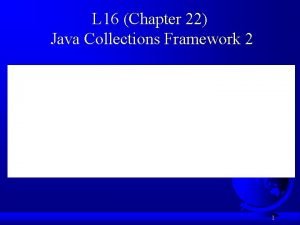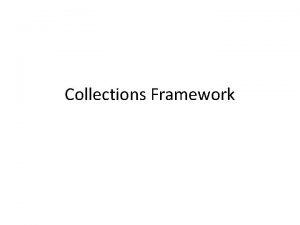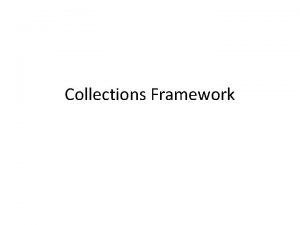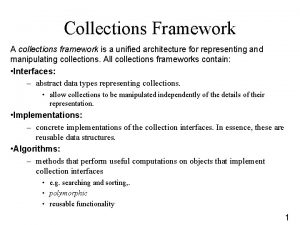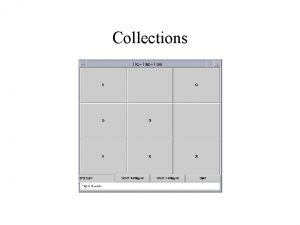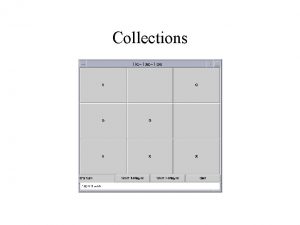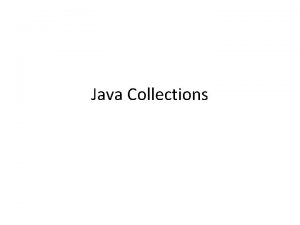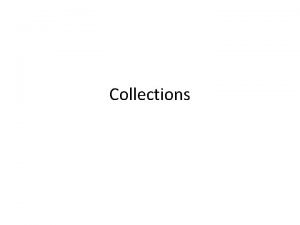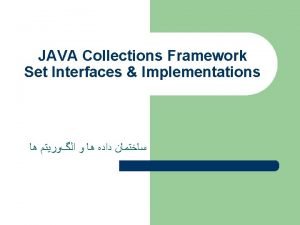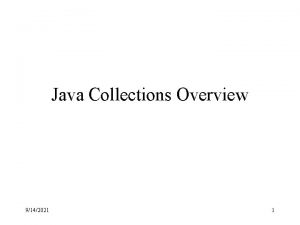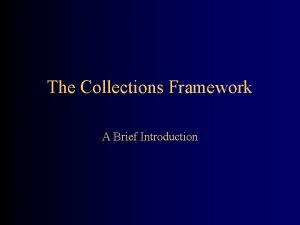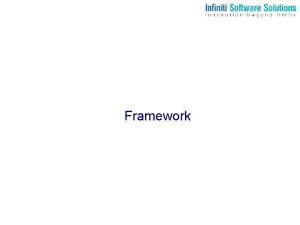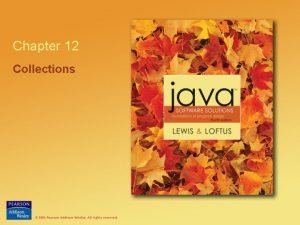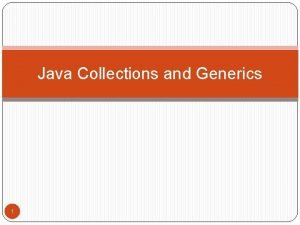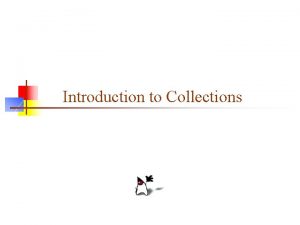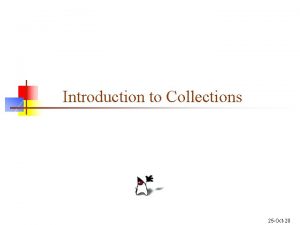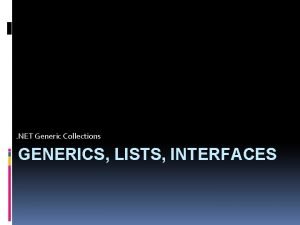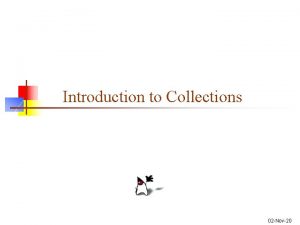Collections COLLECTIONS What is the Collections framework Collections




















![public class Deal { public static void main(String[] args) { if (args. length < public class Deal { public static void main(String[] args) { if (args. length <](https://slidetodoc.com/presentation_image_h2/96c4defc22d9694fd8d6fb6ca1a62f44/image-21.jpg)











- Slides: 32

Collections COLLECTIONS

What is the Collections framework? Collections framework provides two things: ◦ implementations of common high-level data structures: e. g. Maps, Sets, Lists, etc. ◦ An organized class hierarchy with rules/ formality for adding. new implementations

Definition of collection A collection — sometimes called a container — is simply an object that groups multiple elements into a single unit. Collections are used to store, retrieve, manipulate, and communicate aggregate data. They typically represent data items that form a natural group, e. g. ◦ poker hand (a collection of cards), a mail folder (a collection of letters), or a telephone directory (a mapping from names to phone numbers).

General comments about data structures “Containers” for storing data. Different data structures provide different abstractions for getting/setting elements of data. ◦ linked lists ◦ hashtables ◦ vectors ◦ arrays Same data structures can even be implemented in different ways for performance/memory: ◦ queue over linked list ◦ queue over arrays

Collections-related Interface hierarchy Collection List Set Map Iterator Sorted. Map List. Iterator Sorted. Set • The Collection inteface stores groups of Objects, with duplicates allowed • The Set interface extends Collection but forbids duplicates • The List interface extends Collection, allows duplicates, and introduces positional indexing. • Map is a separate hierarchy

Collection implementations Note that Java does not provide any direct implementations of Collection. Rather, concrete implementations are based on other interfaces which extend Collection, such as Set, List, etc. Still, the most general code will be written using Collection to type variables.

Collection Interface boolean add(Object o); boolean add. All(Collection c); void clear(); boolean contains(Object o); boolean contains. All(Collection c); boolean equals(Object o); int hash. Code(); boolean is. Empty(); Iterator iterator(); boolean remove(Object o); boolean remove. All(Collection c); boolean retain. All(Collection c); int size(); Object[] to. Array(Object[] a); Optional operation, throw Unsupported. Operation. Exception

Comments on Collection methods Note the iterator() method, which returns an Object which implements the Iterator interface. Iterator objects are used to traverse elements of the collection in their natural order. Iterator has the following methods: ◦ boolean has. Next(); // are there any more elements? ◦ Object next(); // return the next element ◦ void remove(); // remove the element returned after lest next()

Abstract. Collection Class java. util. Abstract. Collection • Abstract class which is partial implementation of of Collection interface • Implements all methods except iterator() and size() • Makes it much less work to implement Collections Interface

List interface An interface that extends the Collections interface. An ordered collection (also known as a sequence). ◦ The user of this interface has precise control over where in the list each element is inserted. ◦ The user can access elements by their integer index (position in the list), and search for elements in the list. Unlike Set, allows duplicate elements. Provides a special Iterator called List. Iterator for looping through elements of the List.

Additional Methods in List Interface List extends Collection with additional methods for performing index-based operations: ◦ void add(int index, Object element) ◦ boolean add. All(int index, Collection collection) ◦ Object get(int index) ◦ int index. Of(Object element) ◦ int last. Index. Of(Object element) ◦ Object remove(int index) ◦ Object set(int index, Object element)

List/List. Iterator Interface The List interface also provides for working with a subset of the collection, as well as iterating through the entire list in a position friendly manner: ◦ List. Iterator list. Iterator() ◦ List. Iterator list. Iterator(int start. Index) ◦ List sub. List(int from. Index, int to. Index) List. Iterator extends Iterator and adds methods for bi-directional traversal as well as adding/removing elements from the underlying collection.

Randomly shuffling a List import java. util. *; public class Shuffle { public static void main(String[] args) { List<String> list = Arrays. as. List(args); Collections. shuffle(list); System. out. println(list); } }

Concrete List Implementations There are two concrete implementations of the List interface ◦ Linked. List ◦ Array. List Which is best to use depends on specific needs. Linked lists tend to be optimal for inserting/removing elements. Array. Lists are good for traversing elements sequentilly Note that Linked. List and Array. List both extend abstract partial implementations of the List interface.

Linked. List Class The Linked. List class offeres a few additional methods for directly manipulating the ends of the list: ◦ void add. First(Object) ◦ void add. Last(Object); ◦ Object get. First(); ◦ Object get. Last(); ◦ Object remove. First(); ◦ Object remove. Last(); These methods make it natural to implement other simpler data structures, like Stacks and Queues.

Linked. List examples See heavily commented Linked. List Example in course notes A few things to be aware of: ◦ it is really bad to use the positional indexing features copiously of Linked. List if you care at all about performance. This is because the Linked. List has no memory and must always traverse the chain from the beginning. ◦ Elements can be changed both with the List and List. Iterator objects. That latter is often more convenient. ◦ You can create havoc by creating several iterators that you use to mutate the List. There is some protection built-in, but best is to have only one iterator that will actually mutate the list structure.

Array. List Class Also supports the List interface, so top-level code can pretty much invisibly use this class or Linked. List (minus a few additional operations in Linked. List). However, Array. List is much better for using positional index access methods. At the same time, Array. List is much worse at inserting elements. This behavior follows from how Array. Lists are structured: they are just like Vectors.

More on Array. List Additional methods for managing size of underlying array size, is. Empty, get, set, iterator, and list. Iterator methods all run in constant time. Adding n elements take O[n] time. Can explicitly grow capacity in anticipation of adding many elements. Note: legacy Vector class almost identical. Main differences are naming and synchronization. See short Array. List example.

Vector class Like an Array. List, but synchronized for multithreaded programming. Mainly for backwards-compatibility with old java. Used also as base class for Stack implementation.

Stack class Stack() Creates an empty Stack. Method boolean empty() Tests if this stack is empty. E peek() Looks at the object at the top of this stack without removing it from the stack. E pop() Removes the object at the top of this stack and returns that object as the value of this function. E push(E item) Pushes an item onto the top of this stack. int search(Object o) Returns the 1 -based position where an object is on this stack.
![public class Deal public static void mainString args if args length public class Deal { public static void main(String[] args) { if (args. length <](https://slidetodoc.com/presentation_image_h2/96c4defc22d9694fd8d6fb6ca1a62f44/image-21.jpg)
public class Deal { public static void main(String[] args) { if (args. length < 2) { System. out. println("Usage: Deal hands cards"); return; } int num. Hands = Integer. parse. Int(args[0]); int cards. Per. Hand = Integer. parse. Int(args[1]); // Make a normal 52 -card deck. String[] suit = new String[] { "spades", "hearts", "diamonds", "clubs" }; String[] rank = new String[] { "ace", "2", "3", "4", "5", "6", "7", "8", "9", "10", "jack", "queen", "king" }; List<String> deck = new Array. List<String>(); for (int i = 0; i < suit. length; i++) for (int j = 0; j < rank. length; j++) deck. add(rank[j] + " of " + suit[i]); // Shuffle the deck. Collections. shuffle(deck); if (num. Hands * cards. Per. Hand > deck. size()) { System. out. println("Not enough cards. "); return; } for (int i=0; i < num. Hands; i++) System. out. println(deal. Hand(deck, cards. Per. Hand)); } public static <E> List<E> deal. Hand(List<E> deck, int n) { int deck. Size = deck. size(); List<E> hand. View = deck. sub. List(deck. Size - n, deck. Size); List<E> hand = new Array. List<E>(hand. View); hand. View. clear(); return hand; } }

Set Interface Set also extends Collection, but it prohibits duplicate items (this is what defines a Set). No new methods are introduced; specifically, none for index-based operations (elements of Sets are not ordered). Concrete Set implementations contain methods that forbid adding two equal Objects. More formally, sets contain no pair of elements e 1 and e 2 such that e 1. equals(e 2), and at most one null element Java has two implementations: Hash. Set, Tree. Set

Using Sets to find duplicate elements import java. util. *; public class Find. Dups { public static void main(String[] args) { Set<String> s = new Hash. Set<String>(); for (String a : args) if (!s. add(a)) System. out. println("Duplicate detected: " + a); System. out. println(s. size() + " distinct words: " + s); } }

Hash. Sets and hash tables Lists allow for ordered elements, but searching them is very slow. Can speed up search tremendously if you don’t care about ordering. Hash tables let you do this. Drawback is that you have no control over how elements are ordered. hash. Code() computes integer (quickly) which corresponds to position in hash table. Independent of other objects in table.

Hash. Set Class Hashing can be used to implement several important data structures. Simplest of these is Hash. Set ◦ add elements with add(Object) method ◦ contains(Object) is redefined to first look for duplicates. ◦ if duplicate exists, Object is not added What determines a duplicate? ◦ careful here, must redefine both hash. Code() and equals(Object)!

Hash. Set Look Hash. Set. Example. java Play around with some additional methods. Try creating your own classes and override hash. Code method. Do Some timings.

Tree Sets Another concrete set implementation in Java is Tree. Set. Similar to Hash. Set, but one advantage: ◦ While elements are added with no regard for order, they are returned (via iterator) in sorted order. ◦ What is sorted order? ◦ this is defined either by having class implement Comparable interface, or passing a Comparator object to the Tree. Set Constructor. ◦ Latter is more flexible: doesn’t lock in specific sorting rule, for example. Collection could be sorted in one place by name, another by age, etc.

Comparable interface Many java classes already implement this. Try String, Character, Integer, etc. Your own classes will have to do this explicitly: ◦ Comparable defines the method public int compare. To(Object other); ◦ Comparator defines the method public int compare(Object a, Object b); As we discussed before, be aware of the general contracts of these interfaces. See Tree. Set. Example. java

Maps are similar to collections but are actually represented by an entirely different class hierarchy. Maps store objects by key/value pairs: ◦ map. add(“ 1234”, “Andrew”); ◦ ie Object Andrew is stored by Object key 1234 Keys may not be duplicated Each key map to only one value

Java Map interface Methods can be broken down into three groups: ◦ querying ◦ altering ◦ obtaining different views Fairly similar to Collection methods, but Java designers still thought best to make separate hierarchy – no simple answers here.

Map methods Here is a list of the Map methods: ◦ ◦ ◦ void clear() boolean contains. Key(Object) boolean contains. Value(Object) Set entry. Set() boolean get(Object) boolean is. Empty() Set key. Set() Object put(Object, Object) void putall(Map) Object remove(Object) int size() Collection values()

Map Implementations We won’t go into too much detail on Maps. Java provides several common class implementations: ◦ Hash. Map ◦ a hashtable implementation of a map ◦ good for quick searching where order doesn’t matter ◦ must override hash. Code and equals ◦ Tree. Map ◦ A tree implementation of a map ◦ Good when natural ordering is required ◦ Must be able to define ordering for added elements.
 Java collections framework diagram
Java collections framework diagram Drawing a conceptual framework
Drawing a conceptual framework Theoretical framework
Theoretical framework Dispositional framework vs regulatory framework
Dispositional framework vs regulatory framework Dispositional framework vs regulatory framework
Dispositional framework vs regulatory framework What is theoretical framework
What is theoretical framework Theoretical framework
Theoretical framework So nguyen to
So nguyen to đặc điểm cơ thể của người tối cổ
đặc điểm cơ thể của người tối cổ Tỉ lệ cơ thể trẻ em
Tỉ lệ cơ thể trẻ em Phối cảnh
Phối cảnh Các châu lục và đại dương trên thế giới
Các châu lục và đại dương trên thế giới Thế nào là hệ số cao nhất
Thế nào là hệ số cao nhất ưu thế lai là gì
ưu thế lai là gì Sơ đồ cơ thể người
Sơ đồ cơ thể người Môn thể thao bắt đầu bằng từ chạy
Môn thể thao bắt đầu bằng từ chạy Tư thế ngồi viết
Tư thế ngồi viết Hát kết hợp bộ gõ cơ thể
Hát kết hợp bộ gõ cơ thể Cái miệng nó xinh thế chỉ nói điều hay thôi
Cái miệng nó xinh thế chỉ nói điều hay thôi Cách giải mật thư tọa độ
Cách giải mật thư tọa độ Tư thế ngồi viết
Tư thế ngồi viết Gấu đi như thế nào
Gấu đi như thế nào Thẻ vin
Thẻ vin Thể thơ truyền thống
Thể thơ truyền thống Các châu lục và đại dương trên thế giới
Các châu lục và đại dương trên thế giới Sự nuôi và dạy con của hổ
Sự nuôi và dạy con của hổ Từ ngữ thể hiện lòng nhân hậu
Từ ngữ thể hiện lòng nhân hậu Diễn thế sinh thái là
Diễn thế sinh thái là Frameset trong html5
Frameset trong html5 Thế nào là giọng cùng tên? *
Thế nào là giọng cùng tên? * Vẽ hình chiếu vuông góc của vật thể sau
Vẽ hình chiếu vuông góc của vật thể sau Phép trừ bù
Phép trừ bù Lời thề hippocrates
Lời thề hippocrates
